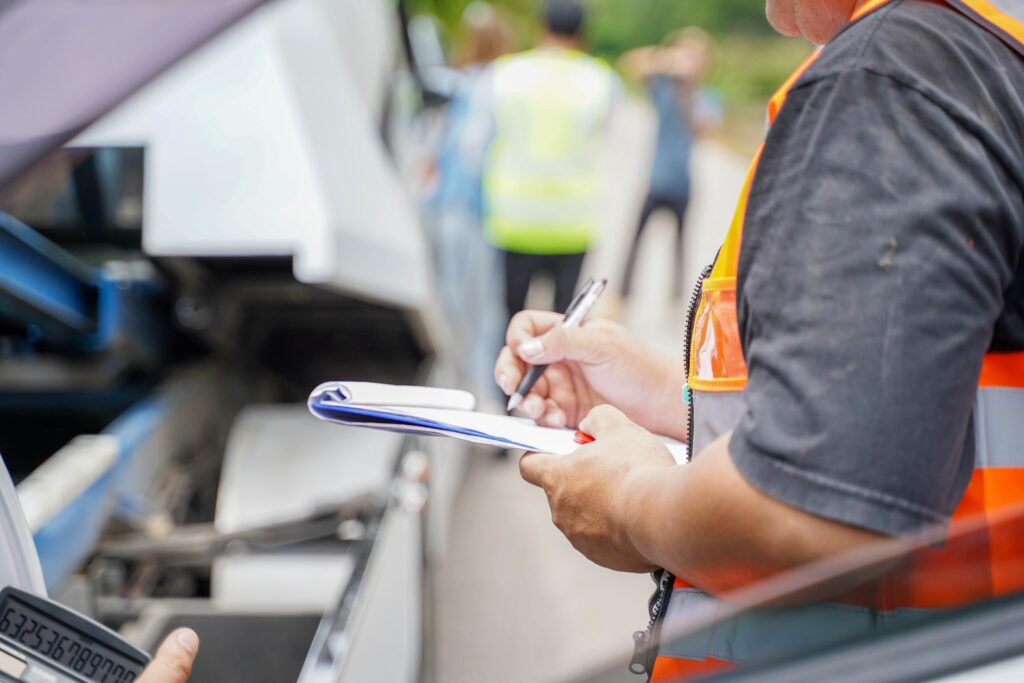Table of Contents
If you are considering a career change and HGV driving looks like the right career for you, there are a few steps you will have to complete before you can get out on the open road.
One of which is the HGV training test.
But don’t panic, you don’t have to spend hours researching online to see what is best for you – we’ve compiled everything you need to know in one place!

What is the HGV training test?
The HGV training testing is actually made up of multiple smaller tests and includes your theory, CPC, and practical driving tests.
- Driver CPC part 1 test: theory – this is referred to as your theory test and involves multiple choice and hazard perception tests.
- Driver CPC part 2 test: case studies (CPC test)
- Driver CPC part 3a test: off-road exercises (CPC test)
- Driver CPC part 3b test: on-road driving – this is your practical driving test.
- Driver CPC part 4 test: practical demonstration (CPC test)
Multiple choice segment
In this section, you will have 1 hour and 15 minutes to answer 100 multiple-choice questions, choosing the correct answer once you have read the question carefully.
You don’t have to use the fill time allowance and can flag questions you aren’t sure about to save them until the end, giving you another chance to answer them correctly.
To pass this section, you will need to score at least 85/100, or you will need to resit it.
Hazard perception segment
In this section, you will watch 19 computer-generated clips of journeys on UK roads and try to spot the hazards as they occur.
18 clips will have 1 developing hazard, and one will have 2, and your job is to identify the hazards by clicking them as quickly as possible to score the maximum number of available points, from a scale of 0-5.
When you click a small red flag will appear at the bottom of your screen so you know it has worked, and while you won’t lose points for clicking at events that are not hazards, repeatedly clicking can be seen as cheating and will lead to a score of 0 for that clip alone.
You will have an hour in total and to pass this section, you will need to score at least 67/100.
What is test day like?
Your theory test day for the HGV theory test is very similar to the same day for your car test and starts with getting yourself to your DVSA test centre in good time.
When you arrive you will asked to store your personal items, such as your coat, phone, and wallet, in a locker or similarly secure location, removing only your driving licence and a bottle of water – though this can differ centre by centre so is worth checking.
Then you will check in, show your documents to the DVSA staff, and sign electronically to confirm your identity, before sitting in the waiting room until it is your allotted time to go in.
Once called, you’ll be taken through to the computer room and the theory test computer process will be explained to you. You will also be asked to empty your pockets and your ears will be visually checked to make sure you aren’t wearing earphones to help you cheat.
You’ll then be shown to your seat and the test will begin – if you have booked to complete both sections you will start with the multiple-choice questions followed by the hazard perception segment.
After your test(s), you’ll go back to the waiting room while the computer system calculates your results, which will be given to you by the DVSA staff on a folded letter – to keep it private.
Whatever your results, you will then leave – it is important to note that even if you need to, you can’t book in for another theory HGV test at the DVSA test centre, you can only do this online.
How long does an HGV test take?
Completing your HGV theory test should take at least 2 hours and 15 minutes, plus extra time for checking in and waiting for your results at the end.
To be sure you aren’t in a rush, it’s best to set aside around 3 hours for your theory test, but rest assured, you will be out of the centre long before then.
It is also encouraged to arrive at the centre with a little time to spare beforehand, to allow you to find the room, use the facilities if you need them, and check in before your allotted time – as if you are late you can be refused entry.

Can I take my HGV driving test in another language?
Unfortunately, as of 7th April 2014, you can no longer take a driving test in any language other than English, Welsh, or British Sign Language (BSL).
This includes the use of:
- A foreign language voiceover on the theory test
- A foreign language interpreter on your theory or practical HGV driving tests
However, there is a vast range of preparation test materials you can use in your native language to help get you ready for your tests – and many of these can be completed on a phone or tablet at your convenience.
Can you book multiple HGV driving tests?
Though it may seem a good way to safeguard against failing, it is not possible to book multiples of the same HGV tests – for example, multiple practical tests.
If you are booking different HGV tests, however, for example, your theory, and practical tests, you can and most likely will have multiple tests booked at once.
This is because the full regimen of HGV driving tests is made up of many smaller tests – including the theory tests, your practical driving test, and the CPC elements.
The bottom line is, that as long as you haven’t booked multiples of the same type of test, you will be fine.
How to pass the HGV test
Every driver wants to pass their HGV driving test first time, firstly as a matter of pride but also to help them save money and get earning faster.
To help with this endeavour, what will help you pass your HGV test the first time?
What skills do I need to pass the HGV licence?
As part of your HGV training, our experienced and helpful instructors will help you develop the skills you need to pass your many HGV tests.
These skills include:
- Communication
- Stress management
- The ability to work independently
- Identifying and dealing with hazards
- Problem-solving
- HGV driving
- Attention to detail
- Effective time management
- Reliability
- Concentration skills
- Patient and calm driving
You may already have developed some of these skills from your educational and working background, which gives you a good head start that you can capitalise on.
HGV driving test pass rates
According to the latest data from the DVSA, the pass rate for the HGV practical theory tests was as follows:
- Multiple-choice questions – 68.7%
- Hazard perception – 84.7%
Which demonstrates an increase in data from the previous year (2020).

How many minors are you allowed on an HGV training test?
Just like with a Cat B car driving test, your practical HGV test has no minimum pass mark and is based on the collection of driving faults while you are behind the wheel.
Faults are classed as either minor or serious/ dangerous, and to pass you need 15 or fewer minors and no serious faults. This could mean you get 4 or 13 minors; it doesn’t matter, you will still pass.
Likewise, you could get 7 or only 1 minor fault, but as soon as you collect 1 serious fault, you will fail.
But try not to worry, as long as you listen to your instructor, drive at a sensible speed for the type of road you are on, and observe regularly, you will be able to anticipate hazards and act in good time – avoiding serious faults.
How to study for your HGV practical test?
If you are currently preparing for your HGV theory test, the most important thing to remember with studying and revision is frequency.
No matter how you revise, doing it in smaller bursts regularly will help you to learn and remember the information you need to pass.
There is now a vast array of materials available to help you pass, from apps to the GOV website, YouTube videos, and even TikToks, but most trainees also use trusted DVSA books, like:
- The Highway Code – just make sure it is the most recent copy
- Know Your Traffic Signs
- The Official DVSA Guide to Driving Goods Vehicles
If you train with HGVTN, you will receive access to free online theory practice software that is designed to help you pass the first time – which can be great for revising at home and on the go!
Minimum driver hours for HGV test
Perhaps surprisingly, there are no minimum driver hours that you must complete before taking your HGV theory test and it is possible to take your theory test before you step behind the wheel, especially if you are taking your theory test before you start your practical training.
However, some encourage you to combine revising for your theory with practical training as it increases your exposure to road signs and markings, as well as common situations that can be covered in the hazard perception segment – helping you to revise in real-time.
It can also help you to pass more quickly, which is important for some learners.
Most common HGV driving test fails
To pass your HGV driving test, you need to make:
- No more than 12 driving faults (or ‘minors’)
- No serious or dangerous faults (or ‘majors’)
In reverse order, the 5 most common reasons people fail their HGV test in the UK are:
5. Move off – safety
Failure to move off safely from a range of road and traffic conditions will result in failure.
It is essential that you always observe effectively, take your time, and only drive on when you are ready.
4. Mirrors – change direction
Another common error is to omit checking in your mirrors before you change direction.
Using mirrors and looking thoroughly before you change direction will help stop this from becoming a hazard and keep you and others safe on UK roads.
3. Control – steering
Just as you would in a car, you mustn’t make contact with the kerb while turning – while gentle contact is unlikely to result in failure, mounting the kerb will probably lead to test failure.
2. Junctions – observations
Surprisingly, the second most common reason for test failure is failing to observe carefully enough at a junction.
Never pull out while not looking and ensure you don’t pull out into a gap that is too small, which means others or even your instructor will have to take action on your behalf.
1. Reverse left – Control
With the most recorded fails according to DVSA data, incorrect control during reversing usually fails HGV drivers.
There is no penalty for taking your time and remaining in control, but thanks to the stress of the situation trainee HGV drivers often rush, become dangerous, and complete it in a manner that puts you and other road users at risk.
Top tips for HGV practical test
In the run-up to your test, we have a range of top tips you can follow to help you pass first time. These include:
- Only taking your test when you are ready
- Checking the details, including what you need to bring and when
- Get a good night’s rest and have something to eat and drink beforehand
- Decide what time you will arrive and make sure not to arrive too early or late
- Wear something comfortable that suits the weather
This will leave you free to focus on the following during your test itself:
- Remove distractions before you set off, including keys, phones, music, etc.
- Check your blind spots regularly
- Use your mirrors, about every 15 seconds or so is best to ensure there are no surprises
- Anticipate things in good time, for example, having to slow down, and complete anticipatory movements smoothly
- Stay calm and get over small mistakes quickly – dwelling on mistakes can lead to sloppier driving

Get HGV test ready with HGVTN
At HGV Training Network we offer HGV training, CPC training and bus driver training from over 50 locations across the UK, allowing you to train close to home and reduce your commute.
We also include free online HGV theory learning materials and one-to-one support to help you become an HGV driver sooner.
To get started, find your nearest location or call us on 0800 254 5007 and we’ll get back to you as soon as we can.








